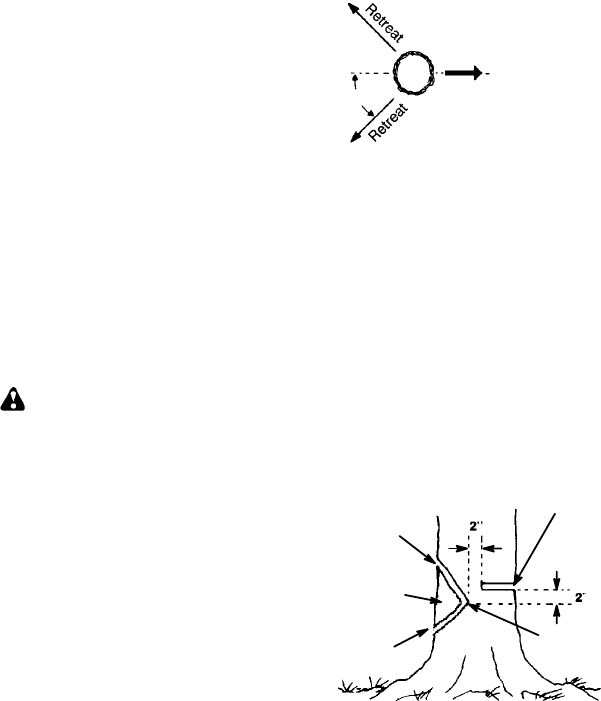
11
OPERATING TIPS
S Check chain tension before first use and
after 1 minute of oper ation. See CHAIN
TENSION in the ASSEMBLY section.
S Cut wood only. Do not cut metal, plastics,
masonry , non-wood building materia ls, e tc.
S Stop the saw if the chain strikes a foreign
object. Inspect the saw and repair or re-
place parts as necessary .
S Keep the chain out of dirt and sand. Even a
small amount of dirt will quickly dull a chain
andthus increase th e p ossibility of kickback.
S Practice cutting a few small logs using the
following techniques to get the“feel” of us-
ing your saw be fore you begin a major
sawing operation.
S Squeeze the throttle trigger and allow the
engine to reach full speed before cutting.
S Begin cutting with the saw frame
against the log.
S Keep theengine at full speed the entire
time you a re cutting.
S Allowthechaintocutforyou. Exertonly
light downward pressure. If you force
the cut,damage tothebar,chain, oren-
gine can result.
S Release the throttle trigger as soon as
the cut is completed, allowing the en-
gine to idle. If you run the saw at full
throttle withouta cutting load,unneces-
sary wear can occur to the chain, bar,
and engine. It is recommended that
the engine not be operated for lon-
ger than 30 seconds at full throttle.
S Toavoidlosingcontrolwhencut iscom-
plete,donotputpressureonsaw a tend
of cut.
S Stop the engine before setting the saw
down after cutting.
TREE FELLING TECHNIQUES
WARNING: Check for broken or
dead branches which can fall while cutting
causingserious injury. Donotcutnearbuild-
ings or electricalwires ifyou donot know the
directionof treefall, norcut atnightsinceyou
will not be ale to see well, nor during bad
weather such as rain, snow,or strongwinds,
etc. If thetree m a kes contact with any utility
line, the utility company should be notified
immediately .
S Carefully planyour sawingoperation inad-
vance.
S Cleartheworkarea. Youneeda cleararea
allaroundthe treeso youcan havesecure
footing.
S The chain saw operator should keep on
the uphill side of the terrain as the tree is
likely torollorslidedownhill afteritis felled.
S Study th e natural condi tions that can cause
the tree to fall in a particular direction.
Natural conditions that can cause a tree to
fall in a particular direction include:
S The wind direction and speed.
S The lean of the tree. The lean of a tree
might not be apparent due to uneven or
sloping terrain. Usea plumb o rlevel tode-
termine the direction of tree lea n.
S Weight and branches on one side.
S Surrounding trees and obstacles.
Look for decay and rot. Ifthe trunk is rotted,
it can snap and fall toward the operator.
Check for broken or dead branches which
can fall on you while cutting.
Make sure there is enough room for the tree to
fall. M aintain a distance of
2-1/2 t ree len gths
from the nearest person or other objects. En-
gine noise can drown out a warning call.
Remove dirt, stones, loose bark, nails, sta-
ples, andwire fromthe treewherecuts areto
be made.
Plan aclearretreat pathto the rear anddiag-
onal to the line of fall.
Direction of Fall
45_
Plan a clear retreat path
FELLING LARGE TREES
(6 inches (15 cm) in diameter or larger)
The notch method is used to fell large trees.
A notchis cut onthe sideofthetreein thede-
sired direction of fall. After a felling cut is
made on the opposite side of tree, the tree
will tend to fall into the notch.
NOTE: If the tree has large buttress roots,
removethembeforemaking thenotch. If u s-
ing saw to remove buttress roots, keep saw
chain fromcontacting groundto preventdull-
ing of the chain.
NOTCH CUT AND FELLING THE
TREE
S Make notch cut by cutting the top of the
notch first. Cut through
1/3 of the diameter
ofthetree. Nextcompletethenotchby cut-
ting the bottom of the notch. See illustra-
tion. Once the notch is cut remove the
notch of wood from the tree.
Notch
First cut
Second cut
Final (felling) cut here, 2 inches
(5 cm) above center of notch.
Hinge
S After removing the wood from the notch,
make the felling cut on the opposite side of
the n otch.Thisis doneby making acut about
two inches (5 cm) higher than the center of
the notch. This will leaveenough uncut wood
between the felling cut and the notch to form
a hinge. This hinge will help prevent the tree
from falling in the wrong direction.


















